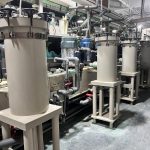# Electroplating Filter: Enhancing Efficiency and Purity in Metal Plating Processes
Electroplating is a critical process in various industries, from automotive to electronics, where a thin layer of metal is deposited onto a substrate to enhance its properties. However, the efficiency and quality of electroplating heavily depend on the purity of the plating solution. This is where electroplating filters come into play, ensuring that the solution remains free from contaminants that could compromise the final product.
## The Role of Electroplating Filters
Electroplating filters are designed to remove impurities from the plating solution, such as particulate matter, oils, and other contaminants. These impurities can originate from various sources, including the raw materials used in the plating process, the environment, or even the equipment itself. By effectively filtering out these contaminants, electroplating filters help maintain the integrity of the plating solution, leading to higher-quality metal deposits.
### Types of Electroplating Filters
There are several types of electroplating filters available, each suited to different applications and levels of filtration:
– **Cartridge Filters**: These are disposable filters that capture particles as the plating solution passes through them. They are easy to replace and are ideal for removing fine particulates.
– **Bag Filters**: Made from durable materials, bag filters are reusable and can handle larger volumes of plating solution. They are effective for removing larger particles and are often used in pre-filtration stages.
– **Depth Filters**: These filters use a thick layer of filtration media to trap particles throughout their depth. They are particularly effective for removing fine particles and are often used in high-purity applications.
## Benefits of Using Electroplating Filters
Incorporating electroplating filters into the metal plating process offers numerous benefits:
– **Improved Plating Quality**: By removing contaminants, filters ensure a smoother and more uniform metal deposit, enhancing the overall quality of the plated product.
– **Extended Bath Life**: Contaminants can degrade the plating solution over time. Filters help maintain the solution’s integrity, extending its usable life and reducing the need for frequent replacements.
– **Cost Savings**: With fewer contaminants, there is less waste and fewer defects, leading to cost savings in materials and labor.
– **Environmental Benefits**: Cleaner plating solutions mean fewer harmful chemicals are released into the environment, contributing to more sustainable manufacturing practices.
## Choosing the Right Electroplating Filter
Selecting the appropriate electroplating filter depends on several factors, including the type of contaminants present, the volume of the plating solution, and the desired level of filtration. It’s essential to consult with a filtration expert to determine the best filter for your specific application.
### Maintenance and Replacement
Regular maintenance and timely replacement of electroplating filters are crucial to ensure their effectiveness. Over time, filters can become clogged with contaminants, reducing their efficiency. Monitoring the filter’s performance and replacing it as needed will help maintain optimal plating conditions.
## Conclusion
Electroplating filters play a vital role in enhancing the efficiency and purity of metal plating processes. By removing contaminants, they ensure high-quality metal deposits, extend the life of plating solutions, and contribute to cost savings and environmental sustainability. Investing in the right electroplating filter and maintaining it properly can significantly improve the outcomes of your plating operations.
Keyword: electroplating filter

